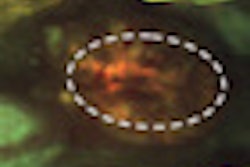
Toluidine blue (TBlue) is a useful adjunct to visual examination in the detection of oral cancer, but its sensitivity is low when used to detect oral epithelial dysplasia, according to a new study by a team of British researchers (Oral Diseases, March 21, 2012).
However, TBlue can be useful for specialists in spotting potentially malignant disorders and reducing unnecessary biopsies.
Potentially malignant disorders of the oral cavity (OPMDs), such as oral leukoplakia and erythroplakia, often precede the development of oral squamous cell carcinomas, the study authors noted. But their benign clinical appearance can make them difficult to diagnose.
As a result, several adjunctive diagnostic clinical tools have been developed to aid in the visualization and detection of OPMDs. One of the most widely studied has been the TBlue test. TBlue is a dye that stains nucleic acids and abnormal tissues and binds preferentially to tissues undergoing rapid cell division. It is marketed by Zila Pharmaceuticals in the form of a swab sold in conjunction with the ViziLite system.
Comparing diagnoses
For this study, the researchers sought to evaluate the accuracy of TBlue staining as an adjunctive test in its ability to identify white and red mucosal lesions already visually diagnosed by a specialist. They also wanted to estimate the sensitivity and specificity of the technique, particularly for diagnosing oral epithelial dysplasia.
The researchers recruited 92 patients more than 16 years old from two London dental clinics who had white and red patches in the oral mucosa. Each patient underwent a visual examination under an incandescent light source from which a clinical diagnosis was made. Among the 92 patients, 10 were diagnosed with frictional keratoses and the rest were classified as OPMDs and clinically characterized to oral leukoplakia, erythroplakia, or erythroleukoplakia.
Following the visual exam, the patients underwent TBlue staining using the ViziLite Plus system. A surgical biopsy was then performed to assess epithelial dysplasia, with the site of the biopsy including any blue-stained area, if present. All 92 cases underwent surgical biopsy from which oral epithelial dysplasia was confirmed in 41 patients.
Of the 41 oral dysplasia cases, a little more than half of the lesions (n = 23) were stain-positive, an estimated sensitivity of 56.1%. The TBlue test had a higher sensitivity for detecting higher grade dysplastic lesions (moderate dysplasia, sensitivity 62.5%; severe dysplasia, sensitivity 71.4%) compared to lower grades of dysplasia, but the differences were not statistically significant (p = 0.60).
In the no-dysplasia group, TBlue staining was positive in 22 (43.1%) of the 51 lesions. The test had a specificity of 56.9% in detecting oral epithelial dysplasia.
Of the 92 patients, 64 were clinically diagnosed as leukoplakia, nine as erythroplakia, and nine as erythroleukoplakia. All nine cases of erythroleukoplakia had candida diagnosed in the biopsy. Ten lesions were clinically diagnosed as frictional keratoses.
Of 64 oral leukoplakias, 34 (53.1 %) stained positive with TBlue and seven of nine erythroplakias stained positive (77.8%). Among the erythroleukoplakia group (n=9), only five stained positive with TBlue.
However, the sensitivity of the test was better for detecting erythroplakia (77.8%) compared with leukoplakia (53.1%). The specificity compared with the frictional keratoses group was similar for both groups (90%).
Low sensitivity
The sensitivity of TBlue as a diagnostic test is low when used for the full range of white and red lesions, the researchers noted. However, in evaluating the dysplasia-only group, TBlue appears to be powerful in determining the higher risk group, they added.
"Based on our results, it is not clear whether the widespread use of TBlue as an adjunct in dental practice would result in an increased number of case detection," the study authors concluded. "But in the hands of specialists its use may reduce a number of unnecessary biopsies and the test result decreases the uncertainty for further investigation."
In a specialist practice, the test has the potential to detect OPMDs but cannot accurately predict the presence of oral epithelial dysplasia, the researchers noted. Further well-designed studies are needed to examine the role of TBlue as an oral examination system or for screening studies in primary care.



















